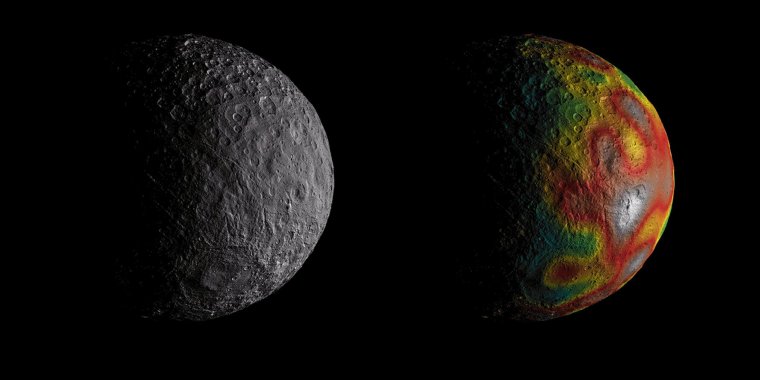| News / Science News |
Dawn Finds Possible Ancient Ocean Remnants at Ceres
The Dawn team found that Ceres' crust is a mixture of ice, salts and hydrated materials that were subjected to past and possibly recent geologic activity, and that this crust represents most of that ancient ocean. The second study builds off the first and suggests there is a softer, easily deformable layer beneath Ceres' rigid surface crust, which could be the signature of residual liquid left over from the ocean, too.

Dawn finds possible ancient ocean remnants at Ceres. ![]()
Landing on Ceres to investigate its interior would be technically challenging and would risk contaminating the dwarf planet. Instead, scientists use Dawn's observations in orbit to measure Ceres' gravity, in order to estimate its composition and interior structure.
Ceres is geologically active -- if not now, then it may have been in the recent past. Three craters -- Occator, Kerwan and Yalode -- and Ceres' solitary tall mountain, Ahuna Mons, are all associated with "gravity anomalies." This means discrepancies between the scientists' models of Ceres' gravity and what Dawn observed in these four locations can be associated with subsurface structures.
The study found the crust's density to be relatively low, closer to that of ice than rocks. However, a study indicated that ice is too soft to be the dominant component of Ceres' strong crust. So, how can Ceres' crust be as light as ice in terms of density, but simultaneously much stronger?
Ceres' crust is likely a mixture of ice, salts, rock and an additional component believed to be clathrate hydrate. A clathrate hydrate is a cage of water molecules surrounding a gas molecule. This structure is 100 to 1,000 times stronger than water ice, despite having nearly the same density.
The researchers believe Ceres once had more pronounced surface features, but they have smoothed out over time. This type of flattening of mountains and valleys requires a high-strength crust resting on a more deformable layer, which contain a little bit of liquid.
The team thinks most of Ceres' ancient ocean is now frozen and bound up in the crust, remaining in the form of ice, clathrate hydrates and salts. It has mostly been that way for more than 4 billion years.
But if there is residual liquid underneath, that ocean is not yet entirely frozen. This is consistent with several thermal evolution models of Ceres published prior to Dawn's arrival there, supporting the idea that Ceres' deeper interior contains liquid left over from its ancient ocean. (NASA)
YOU MAY ALSO LIKE





